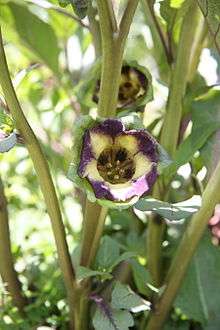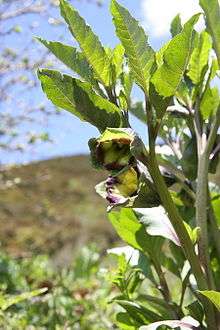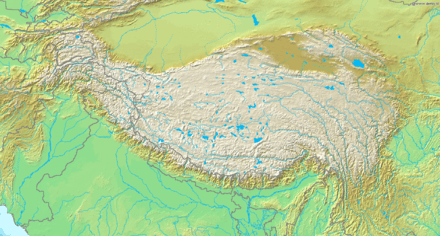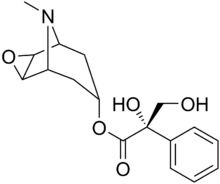Anisodus tanguticus
| Anisodus tanguticus | |
|---|---|
 | |
| Scientific classification | |
| Kingdom: | Plantae |
| (unranked): | Angiosperms |
| (unranked): | Eudicots |
| (unranked): | Asterids |
| Order: | Solanales |
| Family: | Solanaceae |
| Genus: | Anisodus |
| Species: | A. tanguticus |
| Binomial name | |
| Anisodus tanguticus Pascher | |
| Synonyms | |
Anisodus tanguticus is a species of flowering plant in the family Solanaceae which includes many important agricultural plants. It is mostly found growing in the Qinghai-Tibetan Plateau. A. tanguticus is collected and used mostly for its medicinal effects thought to be derived from the plants biologically active nicotine and tropane alkaloids. It has a significant impact in China as one of the 50 traditional herbs used in traditional Chinese medicine.
Alternative names
Anisodus tanguticus is more commonly known in China as shān làngdàng (山莨菪) or Zang Qie.
Description

Anisodus tanguticus is a perennial plant. It has flowers that are mostly solitary and borne in leaf axils. The flowers are mostly star shaped and radial. Most of them are nodding but they can sometimes become erect.
The pedicels have a range of lengths, but most are around at an average of about 1.5–11 centimetres (0.59–4.33 in) long. These pedicels can either have no hair or bristles (glabrous) or be covered with hair (pubescent).
The calyx or sepals are often found in a funnel shape and usually average about 2.5–4 centimetres (0.98–1.57 in) long.
Most of the lobes of A. tanguticus appear broadly dentate. Closer examination of these lobes reveal one to two lobes being larger and longer than the other lobes. The apex of these lobes are either acute or obtuse and are slightly unequal and do not have any hair on them.
The petals that make up the corolla appear in a range of colors. Most of the time they are purple to dark purple, but in some cases can even appear pale yellow to green. These petals are also arranged into a funnel and tend to grow between 2.5–4 cm long.
The stamens are located at the base of the corolla tube and are half the length of the corolla. The filaments are about 0.8 cm long and are hairless.
The anthers are shaped oblong with length of about 5–6 millimetres (0.20–0.24 in). Upon maturity, they tend to dehisce longitudinally.
The ovary is shaped like a cone and above it has styles that are approximately 1.2 centimetres (0.47 in) long. The stigma at the top are often shaped like a disc and dehisce a little bit upon maturity.[2]
A few pollinators of the plant include flies, honeybees, and ants.
Distribution
A. tanguticus is mainly distributed on the Tibetan Plateau. It is present from altitudes from 2,800 to 4,200 metres (9,200 to 13,800 ft). The population of A. tanguticus has decreased significantly from this region due to extensive collecting primarily due to its medicinal uses.[3]

Due to its distribution on the Tibetan Plateau, which includes many mountains and valleys, A. tanguticus can be found in very isolated areas relative to another patch of the same plant. This has led to a high level of genetic differentiation of A. tanguticus.
However, it is easily found around settlements and monasteries. It seems to thrive on nutrient rich location, fertilized by animal dung.
Medicinal uses
A. tanguticus (Chinese: 山莨菪; pinyin: shān làng dàng)[1] is one of the 50 fundamental herbs used in traditional Chinese medicine.
It has high levels of two tropane alkaloids called hyoscyamine and scopolamine. These chemicals primarily affect the parasympathetic nervous system and can act as anticholinergic agents.[3]
Derived drugs


Anisodamine and anisodine are two drugs that are derived from A. tanguticus. These are primarily from the plant's tropane alkaloids that are harvested through its roots. Both drugs are anticholinergic and are sometimes used to treat acute circulatory shock. These drugs primarily act through by being an anticholinergic agent.[4]
Anisodamine in particular was introduced into clinical use in China in 1965 through the manufacture of a synthetic drug that concentrated the alkaloids from the plant. It was first used to treat epidemic meningitis, but was later used to treat other ailments. These included glomerular nephritis, rheumatoid arthritis, hemorrhagic necrotic enteritis, eclampsia, and lung edema, along with shock.[5]
Attempts to increase population
The population of A. tanguticus is starting to dwindle in its main habitat of Qinghai-Tibet Plateau in China. In addition to its collection for its medicinal purposes, the germination rate of A. tanguticus is very low, even under most natural conditions. This is probably due to its seeds which have a very hard seed coat which prevent water absorption and also act to inhibit gaseous exchange. The seeds of A. tanguticus are therefore classified as having coat-imposed dormancy.
A study conducted tried to find a way to break the dormancy in order to help germinate the seeds. They used several combinations of treatments which included chilling, gibberellic acid, and mechanical scarification.
The scarification method, which included breaking, scratching, or softening of the seed coat, was found to be the only way to increase germination. The rate improved to about 70% and the germination time was improved to 4.1 days.
The study hoped to find ways to increase the population of the plant.[6]
References
- 1 2 3 "Anisodus tanguticus in Flora of China @efloras.org". Archived from the original on 3 March 2008. Retrieved 2008-02-05.
- ↑ Yang DZ, Zhang ZY, Lu AM, Sun K, Liu JQ (2002). "Floral organogenesis and development of two taxa of the Solanaceae — Anisodus tanguticus and Atropa belladonna". Israel Journal of Plant Sciences. 50 (1): 127–134. doi:10.1560/9J1P-6GCQ-M375-51P4.
- 1 2 Zheng W, Wang L, Meng L, Liu J (2008). "Genetic variation in the endangered Anisodus tanguticus (Solanaceae), an alpine perennial endemic to the Qinghai-Tibetan Plateau". Genetica. 132 (1): 123–129. doi:10.1007/s10709-007-9154-5. PMID 17516136.
- ↑ Varma DR, Yue TL (March 1986). "Adrenoceptor blocking properties of atropine-like agents anisodamine and anisodine on brain and cardiovascular tissues of rats". British Journal of Pharmacology. 87 (3): 587–94. doi:10.1111/j.1476-5381.1986.tb10201.x. PMC 1916562
 . PMID 2879586.
. PMID 2879586. - ↑ Xiu RJ & Intaglietta M (1984). "Improvement of microvascular function by Chinese vasocative substanc". Advances in Chinese Medicinal Materials Research. 1 (1): 553–557.
- ↑ He T & Jai JF (2009). "Breaking dormancy in seeds of Anisodus tanguticus: an endangered medicinal herb of high altitude in the Qinghai-Tibet Plateau". Seed Science and Technology. 37 (1): 229–231.
External links
| Wikimedia Commons has media related to Anisodus tanguticus. |